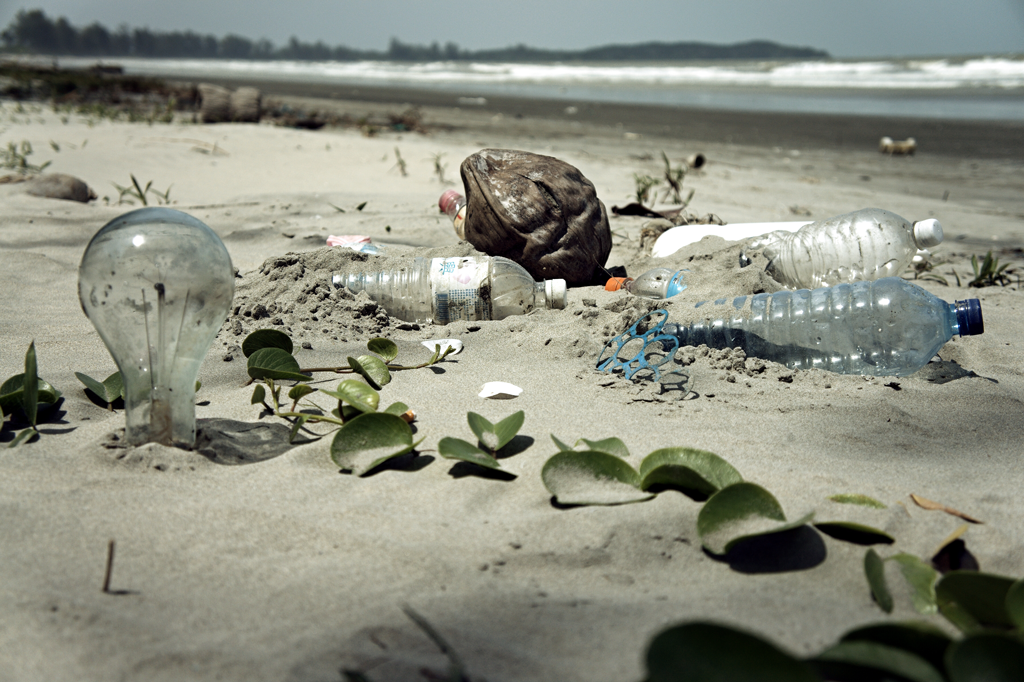By Dessa Bayrock (Cascade Alum) – Email
Print Edition: June 18, 2014

Plastic is everywhere.
But could we have reached the point where plastic is considered part of the natural world?
After studying rocks from a Hawaiian beach, Dr. Patricia Corcoran from the University of Western Ontario thinks it might be fair to say the world has entered the Anthropocene epoch — which is “marked by human interaction with Earth’s biophysical system,” she notes in a recent paper, titled “An anthropogenci marker horizon in the future rock record” published in GSA Today.
And when looking at human interaction with the planet, pollution is a good place to start.
Corcoran and her team headed to Kamilo Beach on Hawaii’s Big Island after she was told about the existence of strange rocks. Half plastic, half debris, fused together into a whole: plastiglomerate.
The team studied 21 sites on Kamilo Beach, and found examples of the plastic-rock hybrid at every one. But how was plastiglomerate created, and what were the larger ramifications?
The first thing Corcoran noted was the remote nature of the beach; because it’s 12 km from the closest paved road, the likelihood of visitors leaving their trash increases.
“The remoteness of the beach plays an important role in the formation of a potential plastiglomerate marker horizon, as most visitors camp for extended periods of time,” the report reads. “In addition, regular, organized beach clean-ups are difficult.”
The research team found that the beach was littered with plastic — some of which had been left behind by visitors, and other pieces that had washed ashore. The variety ranged from fishing equipment to “plastic confetti” — plastic worn into tiny pieces by water and weather, and impossible to pick up.
Because of the pervasiveness of plastic on the beach, it would be impossible to find a plastic-free area to build a camp or bonfire.
The result? Plastics emerge from beach fires fused to other materials, like coral, shell, rocks, sand, and charcoal. The substance is what Science magazine referred to as a “junkyard frankenstein” — impossible to pry apart, and a new material altogether.
Corcoran noted that the same effect could be achieved by lava flows, forest fires, and so on — although Kamilo Beach in particular doesn’t have a history of lava activity, other beaches in Hawaii might see plastiglomerate form near volcanos.
The team observed two kinds of this new plastic rock: situations where plastic has melted to a larger piece of rock, perhaps sinking into the cracks and crevices, and situations where plastic and debris mix in roughly equal measure in a “plastic matrix.” Either way, forming into a plastiglomerate increases the plastic’s chance at survival; when the lump gets heavy enough, it can sink into the soil or the ocean, away from the rays of the sun which seek to break it down. In this way, Corcoran says, the plastiglomerate can stay preserved indefinitely — perhaps eventually making its way into the fossil record and serving as an identifier of the Anthropocene epoch.
“Given the ubiquity of nondegradable plastic debris on our planet, the possibility of their global preservation is strong,” the study reads. “Our study presents the first rock type composed partially of plastic material that has strong potential to act as a global marker horizon in the Anthropocene.”
Corcoran also believes that plastiglomerate is probably common on beaches around the world since all that’s needed for the rock to form are bits of plastic and a hot fire. Now that there’s a name for it, she believes it will be identified on beaches all over the world.
Geophysicist Douglas Jerolmack, quoted in Science magazine, says the substance may be more prevalent than we think.
“All around the world where there’s trash being openly burned in mass quantities,” he notes. “You can imagine there are even larger melted plastic deposits.”


